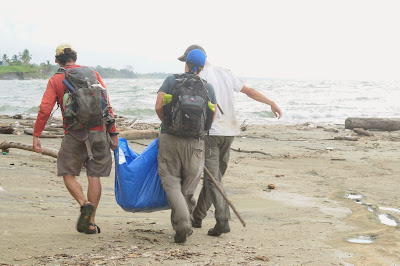Trash road cetacean
As you may have read previously (here, here and here) collecting fossil vertebrates in the Chagres Formation is not an easy task and takes some planning before collecting each specimen. Back in the summer I found what seemed to be the remains of a fossil cetacean partially exposed on on the wave cut platform (see pictures below). To get to this locality we had to walk through a 10 meter stretch of road that is always full of trash, hence the locality name. As for the fossils, not a lot of it was exposed, and the day when we found it, we were on another mission. So we ended going back to the site to collect the fossils two days before Thanksgiving Day, and like most other digs here, we only had about four hours before the high tide took over.
 |
| Left: The exposed fossil; right: Chris (Summer 2013 intern) looking at it somewhat in disbelief. |
 |
| Finally, in November we collected the fossil. James and I started digging the trench around the fossil, soon after the other interns joined the digging party. |
 |
| Zach, Sarah, Elena and James (Fall 2013 interns) are happily posing with the jacketed fossil, it only took us about 2 and a half hours. |
 |
| The site, which I dubbed Chagres Norte, was one of the northern-most localities near the village of Piña. |
At this site as with others along this whole coast, the Chagres Formation is exposed along the wave-cut platforms and sea cliffs. One of the fossils we knew was there (Roger and Austin had found it some days earlier) was part of the vertebral column of a small cetacean.
 | ||||
| Elena (Fall 2014 intern), Roger and Austin collect the cetacean vertebrae. This is one of the reasons I like these guys, even of they specialize in invertebrates, they know not to ignore vertebrate fossils and will collect them.
This was Elena's second day in the field. She got hooked on the Chagres and even "claimed" the fossil saying that she was going to do the prep work, which she did.
Chagres Sur odontocete
Later that day, we went to another locality, this one south of Piña, so I gave it the obvious name of Chagres Sur. At this site I spotted some cetacean fossils sticking out of the sea cliff (see picture below).
At that point, I didn't know what this fossil was, and we were also running out of daylight, so we left it there, and hoped to come back another day to collect it. It wasn't until a couple of weeks ago (1st week of December), that I decided to re-visit the locality with the interns. It was then, upon seeing this fossil again, that I had one of those, aha! moments and I realized what it was. So we had to collect it!
I won't go into details of what the fossil is at this moment (I warned you this was a post to spark your curiosity). But, if you plan on attending the 10th North American Paleontological Convention in Florida next February, you'll definitely find out more about it!
So stay tuned, you'll hear more about these discoveries in 2014!
|










